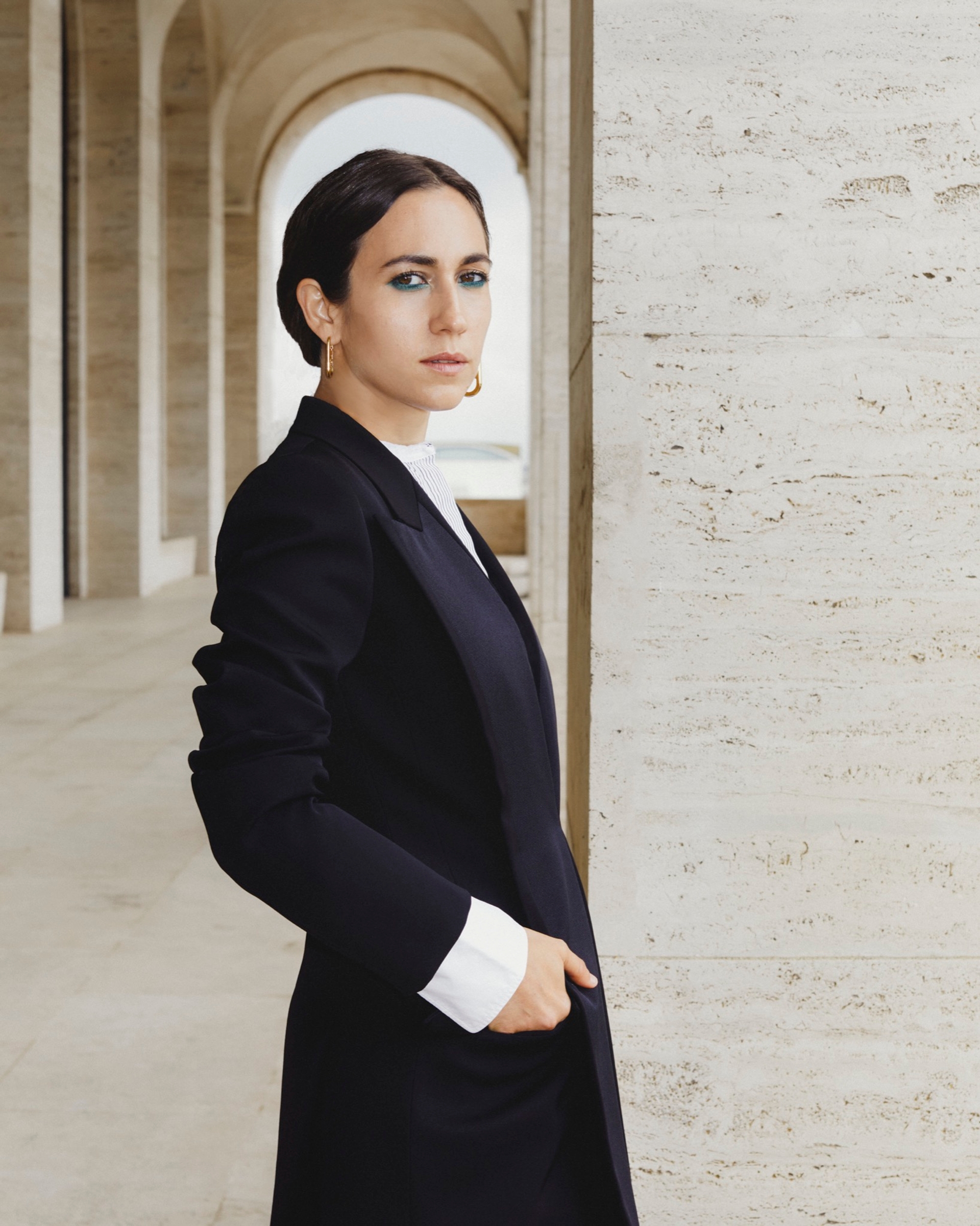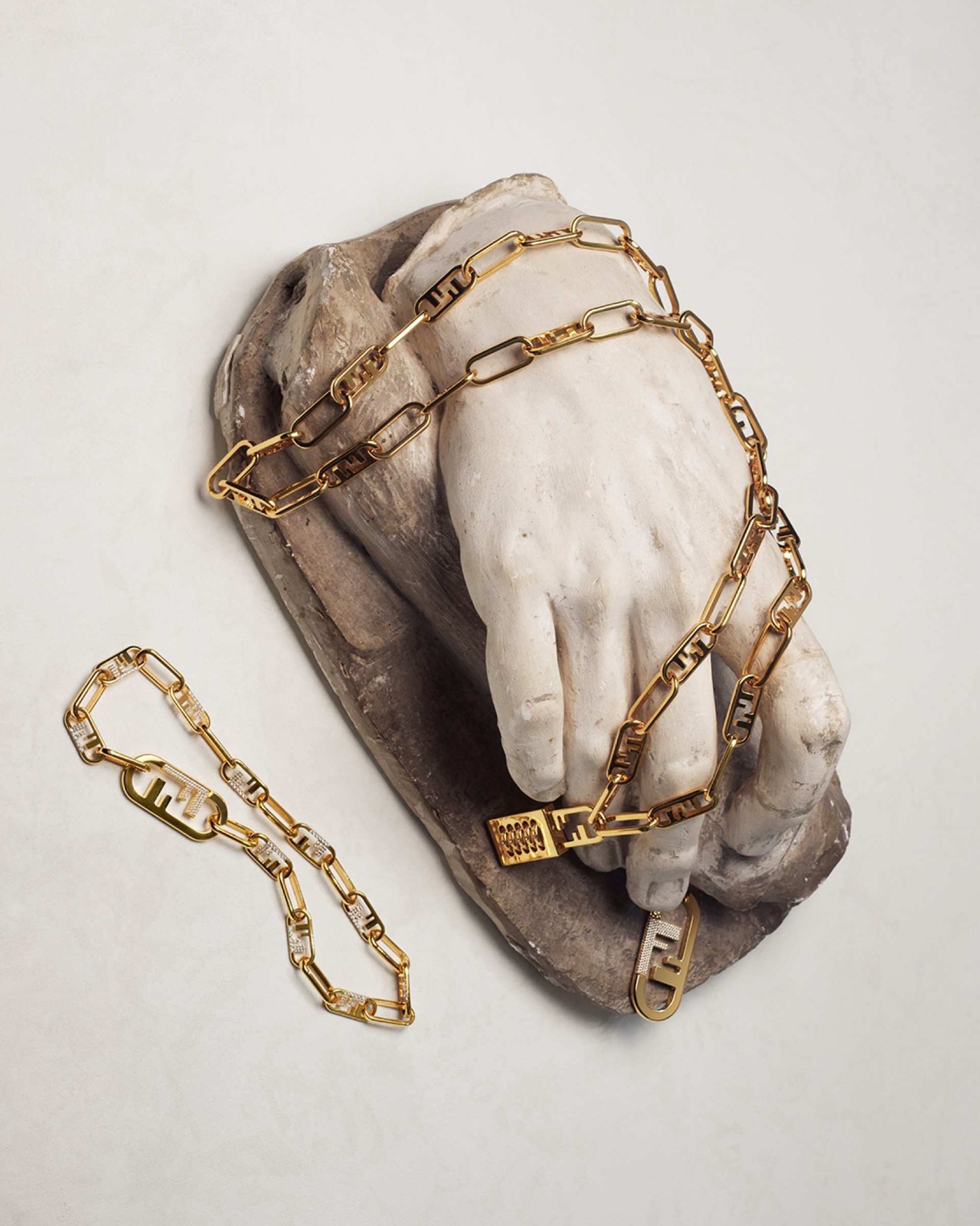The Double F Chromosome: DELFINA DELETTREZ FENDI
Photo: Luca Anzalone
Delfina Delettrez Fendi finds magic in new technology and in the ancient city of Rome, her home town. Since founding her namesake label in 2007, the jewelry designer has been known for gothic, surrealist designs laden with symbolism – occult motifs rendered in precious metals and gemstones with a kind of synchretist fluidity. A fourth-generation native of luxury Italian fashion, Delettrez also brings her charmed sensibility to Fendi, channeling the powers of her “double-F chromosome” into innovating – and transmitting – jewelry tradition in her creations for the family brand. The preferred mystical divination method at Fendi, she explains, is numerology:
Delfina Delettrez Fendi: Five is a magical number at Fendi. There are five Fendi sisters and five letters in the word Fendi. We also often try to find names with five letters for the items. The Autumn/Winter 2021 collection is called O’Lock, a play on “five o’clock,” a sacred hour. During lockdown, I spent a lot of afternoons at the Palazzo Della Civilita Italiana, where I imagined inserting our double-F logo inside the building’s oval arches. The square logo is practically my family crest, but I wanted to round it, to make it more sinuous and feminine, while maintaining a masculine touch.
Victoria Camblin: And integrating the architecture of Rome into the Fendi insignia. How do you relate creatively to the city, and how else is Roman culture present in your work and in the Fendi brand?
Our family has been in Rome for generations. It would have been easy to move to Milan when the rest of the industry went there, but in Milan everyone looks in the same direction. In Rome we are completely outside the fashion circuit – or circus – and this helps to have a more unexpected and personal point of view. We have always had a strong link with the city and its community of intellectuals and creatives. Fendi did cinematic collaborations and created costumes for Fellini, Visconti, and Rossellini, when Rome was called “Hollywood on the Tiber.” Rome is a city of contrasts and clashes, where the Baroque co-exists with the Egyptian obelisk, the sacred and the profane. Being here is like being under a magical spell.
Inhabiting the old and the new is also something you have to do at a heritage label, where you have to honor the brand legacy while refreshing it. Sometimes I call this the “heritage problem.”
The heritage “problem” isn’t a problem, because representing the past and the future is in my DNA. I always say I was born with a “double-F chromosome,” and raised on milk and fashion. Being born into this family was a great privilege, as was being raised in Rome, where the past and present co-exist in such a fantastic and organic way.For years, Fendi had this symbol that was a mythical, double-headed figure with two eyes looking toward the past and two eyes toward the future. Fendi has always been open to experimentation, but also a keeper of tradition and savoir faire. And I think this perfect balance is also what the jewelry world needs, because tradition should be preserved, but must also be reinvented to allow us to explore new materials and technologies. I often am twisting traditions, taking what has already been done while finding new stimuli and combining them in my own vision, because I think women are changing — changing the way they are buying and thinking about jewelry. During the pandemic, the sector had huge growth, I think because we need something symbolic. We want objects that give us meaning, that give us hope and give us strength.
Photo: Casper Sejersen
In ready-to-wear and couture, the question of sustainability is becoming more present. Is it also present in the jewelry sector?
The question isn’t necessarily one of sustainability since we use natural materials. The question is rather of ethics. For my own brand, I’m starting to use ethical gold and recycled silver, and Fendi has plans for this as well.
To get back to the technology, they’re now producing humanmade diamonds, which have the exact molecules of a natural diamond. The only way you can tell it’s humanmade is that you can’t find any imperfections. It’s too perfect, and nature never makes anything that ideal.
People are also interested in perfections. That’s what makes every stone unique.
Now, you have to think about adaptability, to make designs that respond to infinitely more unpredictable situations than you might have had to 10 years ago. Do you see your sinuous, liquified take on the Fendi monogram as symbolic of the flexibility we need to have for our current times?
I think this kind of fluidity also impacts how we think, how we create. In fact, you need to be fluid to be creative. Never say no, and always be ready to reconsider. This is the most powerful tool a person can have. Fendi’s never a straight line. For O’Lock, I wanted to make an homage to Karl [Lagerfeld], transforming the Karligraphy logo he designed in the early 1980s into a wax seal stamp, like those used for old love letters and contracts. It was my way of securing my love for Fendi, locking it in. There is always a twist, a clash, a contrast, a hidden joke. A touch of irony and lightness is what makes Fendi so powerful and strong. Never take yourself too seriously.
Heritage isn’t treated as a problem in the Roman view, as you say – it’s just kind of added to, or not, and there’s a lightness and grace to that. You have ancient columns that were first made into functional walls, and now people project movies on them. What do you foresee for the future, for how technology can be used to integrate new ideas into historical ones?
I love technology. I think that technology is the closest thing to magic. I can be truly attached to the minerality and the artisanal aspect of jewelry design, but also be deeply, deeply inspired and influenced by technology. For example, with the 3-D printer, I can be more precise in the very first steps of the design process, and this reduces waste and risk. Yet I’m also really inspired by taking risks and by the gifts of mistakes, and seeing things that aren’t completely refined. I remember looking at a Selleria bag as a child and asking my mom: “How come you work so much but then end up with bags where every stitch is different from the other?” She was like, “But Delfina, this is the beauty of it.”
Photo: Casper Sejersen
Photo: Casper Sejersen
Photo: Casper Sejersen
Your own brand previously had a touch of Surrealism in the pieces. Does this continue to inspire you?
I’m attracted by extremes — by dressing like a tropical bird one day and a nun the next. If you put the couture, the glass pieces, and the Fendi O’Lock on the same table, you’d think they were done by different people. I like this bipolarity.
This bipolarity, or darkness and light, are actually “on brand,” right?
It’s the Baroque influence, the mixture of the sacred and profane, which you breathe here in Rome. The Baroque is rooted in surprise, in the contrast of shapes that create some perhaps absurd seeming combinations, but which have an aesthetic perfection.
When I started my brand, I was pregnant. I was giving life, but I also started fearing dying. I became fascinated with the fragility of life, which is why I wanted to create a ring for myself of two skeleton hands holding a ruby. I remember having a large tummy and showing this ring to my family and friends, and them being like “are you OK? Why did you make something so macabre?”
You know that I’m happy when I start getting obsessed with death and the obscure.
Are you interested in the occult?
I am. I’m not the typical Roman Catholic. I tend to question myself more. I’m very interested in the light and the dark.
Your current aesthetic still has this Gothic flair. It’s like you’re exploring the border between worlds.
Even long ago, jewelry was important in burial rights. The deceased were adorned with jewelry as a gift to higher powers.
And besides: gold apparently comes from a supernova flash, from the sky, and not from the soil. So, who wouldn’t be interested in other worlds?

